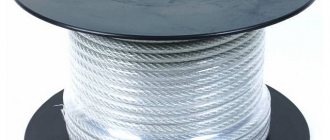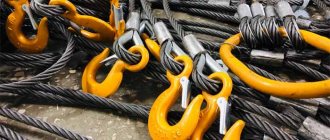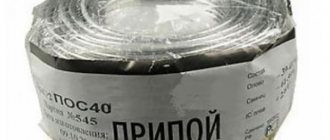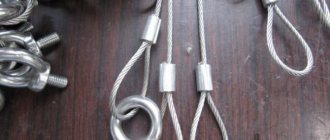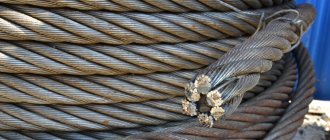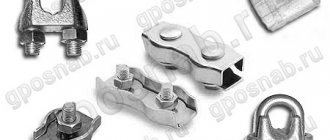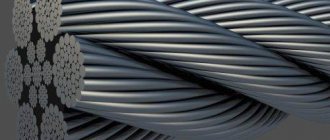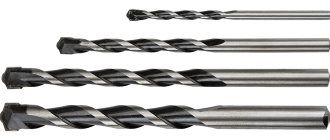The information below on the classification of ropes is far from new, and we cannot add practically anything new. You can easily find similar materials on other resources, so why do we host it? Looking at the classification below, you will understand that there are a large number of types of rope and sometimes even a specialist can find it quite difficult to understand what Rope 12—GL—VK—L—O—N—1770 GOST 2688–80 is.
Working with the same ropes, it’s quite easy to decipher everything, but if the client wants to buy a non-standard rope? This is where “Where to watch?” comes in. Where to get? What does this letter in the name mean? We have previously published material about ropes, but did not describe the classification in detail, so we hope that this article will be useful to you.
Classification, technical requirements, test methods, rules for acceptance, transportation, and storage of steel ropes are set out in GOST 3241-91 “Steel ropes. Technical conditions".
Classification of steel ropes
1. According to the main design feature:
- single lay or spiral wires consist of wires twisted in a spiral into one or several concentric layers. Single lay ropes, twisted only from round wire, are called ordinary spiral ropes. Spiral ropes that have shaped wires in the outer layer are called ropes of a closed structure. Single lay ropes intended for subsequent laying are called strands.
- double lays consist of strands twisted into one or more concentric layers. Double lay ropes can be single-layer or multi-layer. Single-layer six-strand double lay ropes are widely used. Double lay ropes intended for subsequent laying are called strands.
- triple lays consist of strands twisted in a spiral into one concentric layer.
2. According to the cross-sectional shape of the strands:
- round
- shaped strands (three-sided strands, flat strands) have a significantly larger surface area for contact with the pulley than round stranded ones.
3. By type of laying of strands and single lay ropes:
- TK - with point contact of wires between layers,
- LC - with linear contact of wires between layers,
- LK-O - with linear contact of wires between layers with the same diameter of wires along the layers of the strand,
- LK-R - with linear contact of wires between layers with different diameters of wires in the outer layer of the strand,
- LK-Z - with linear contact of the wires between the layers of the strand and the filling wires,
- LK-RO - with linear contact of wires between layers and having in strands layers with wires of different diameters and layers with wires of the same diameter,
- TLC - with a combined point-linear contact of wires in strands.
Strands with point contact of wires are produced in several technological operations depending on the number of layers of wires. In this case, it is necessary to apply different wire laying steps for each layer of the strand and twist the next layer in the opposite direction to the previous one. As a result, the wires between the layers intersect. This arrangement of wires increases their wear during shear during operation, creates significant contact stresses that promote the development of fatigue cracks in the wires, and reduces the coefficient of filling of the rope section with metal. Strands with linear contact of wires are produced in one technological step; At the same time, the consistency of the lay pitch is maintained, and the same direction of the lay of the wires for all layers of the strand, which, with the correct selection of wire diameters across the layers, results in a linear contact of the wires between the layers. As a result, the wear of the wires is significantly reduced and the performance of ropes with linear contact of the wires in the strands increases sharply in comparison with the performance of TK type ropes. Strands of point-linear touch are used when it is necessary to replace the central wire in linear touch strands with a seven-wire strand, when a layer of wires of the same diameter with a point touch is laid on a single-layer seven-wire strand of the LK type. The strands may have increased anti-twist properties.
4. According to core material:
- OS - with an organic core - as a core in the center of the rope, and sometimes in the center of the strands, cores made of natural, synthetic and artificial materials are used - hemp, manila, sisal, cotton yarn, polyethylene, polypropylene, nylon, lavsan, viscose, asbestos.
- MC - with a metal core - in most designs, a double lay rope of six to seven wire strands located around a central seven wire strand is used as a core; in ropes in accordance with GOST 3066-80, 3067-88, 3068-88, MC is used as MC a strand of the same design as in the braid. It is advisable to use them when it is necessary to increase the structural strength of the rope, reduce the structural elongation of the rope during tension, and also at high temperatures of the environment in which the rope operates.
5. According to the laying method:
- Non-untwisting ropes - H - strands and wires retain a given position after removing the ties from the end of the rope or are easily laid manually with slight untwisting, which is achieved by preliminary deformation of the wires and strands when twisting the wires into a strand and strands into a rope.
- Unwinding ropes - wires and strands are not pre-deformed or are insufficiently deformed before they are laid into strands and into a rope. Therefore, the strands in the rope and the wires in the strands do not retain their position after the ties are removed from the end of the rope.
6. By degree of balance:
- The straightened rope - P - does not lose its straightness (within the permissible deviation) in a free suspended state or on a horizontal plane, because After laying the strands and spar, respectively, the stresses from deformation of the wires and strands are removed by straightening.
- Unstraightened rope does not have this property; the free end of an unstraightened rope tends to form a ring due to the deformation stresses of the wires and strands obtained during the rope manufacturing process.
7. In the direction of the rope lay:
- Right lay - not indicated
- Left lay - L
The direction of lay of the rope is determined by: the direction of lay of the outer layer wires - for single lay ropes; direction of lay of the outer layer strands - for double lay ropes; direction of lay of the strands into the rope - for triple lay ropes
8. According to the combination of lay directions of the rope and its elements:
- Cross lay - the direction of lay of strands and strands is opposite to the direction of lay of the rope.
- One-sided lay - O - the direction of lay of the strands into the rope and the wires in the strands are the same.
- Combined lay - K with the simultaneous use of strands of the right and left directions of lay in the rope.
9. According to the degree of coolness
- Torsional - with the same direction of lay of all strands along the layers of the rope (six- and eight-strand ropes with an organic and metal core)
- Low-twisting - (MC) with the opposite direction of lay of rope elements in layers (multi-layer, multi-strand ropes and single lay ropes). In non-rotating ropes, due to the selection of laying directions of individual layers of wires (in spiral ropes) or strands (in multilayer double lay ropes), rotation of the rope around its axis is eliminated when the load is freely suspended.
10. According to the mechanical properties of the wire
- Brand VK - high quality
- Grade B - high quality
- Brand 1 - normal quality
11. According to the type of surface coating of the wires in the rope:
- Made from uncoated wires
- From galvanized wire , depending on the surface density of zinc:
- group C - for medium aggressive working conditions
- group Ж - for harsh aggressive working conditions
- coolant group - especially harsh aggressive working conditions
- P - rope or strands coated with polymer materials
12. According to the purpose of the rope
- Cargo - GL - for lifting and transporting people and cargo
- Freight - G - for lifting and transporting cargo
13. According to manufacturing accuracy
- Normal accuracy - not indicated
- Increased accuracy - T - tightened maximum deviations along the rope diameter
14. According to the strength characteristics of Marking groups of temporary tensile strength N/mm2 (kgf/mm2) - 1370 (140), 1470 (150), 1570 (160), 1670 (170), 1770 (180), 1860 (190), 1960 (200), 2060 (210), 2160 (220)
Why is cable lubrication needed?
To increase the service life of steel cables, you need to properly care for them. Smoothing of ropes is a mandatory measure, the main task of which is to protect against corrosion and mechanical damage. Experts advise applying lubricants in a thin layer of about 0.2 m. Lubricants are used in the manufacture of cables and their operation.
Regular lubrication of ropes ensures longevity and performs other tasks:
- Prevents deformation by ensuring maximum penetration of individual strands.
- Protects against corrosion, preventing premature failure of the metal product.
- Provides resistance to washout, guaranteeing protection in wet conditions and other external factors.
- Reduces friction, reducing abrasion and wear.
The lubricant guarantees resistance to water, ideal for high pressure spraying - low viscosity product. It exhibits high temperature stability, providing protection at high temperatures. The composition can be used at low temperatures.
Examples of symbols for steel ropes
- Rope 16.5 - G - I - N - R - T - 1960 GOST 2688 - 80 Rope with a diameter of 16.5 mm, cargo purpose, first grade, made of uncoated wire, right-hand cross lay, non-unwinding, straightened, high precision, marking group 1960 N/mm2 (200 kgf/mm2), according to GOST 2688 - 80
- Rope 12 - GL - VK - L - O - N - 1770 GOST 2688 - 80 Rope with a diameter of 12.0 mm, for cargo purposes, grade VK, made of uncoated wire, left one-sided lay, non-unwinding, unstraightened, normal accuracy, marking group 1770 N/mm2 (180 kgf/mm2), according to GOST 2688-80
- Rope 25.5 - G - VK - S - N - R - T - 1670 GOST 7668 - 80 Rope with a diameter of 25.5 mm, cargo purpose, grade VK, galvanized according to group C, right-hand cross lay, non-unwinding, straightened, increased accuracy , marking group 1670 N/mm2 (170 kgf/mm2), according to GOST 7668 - 80
- Rope 5.6 - G - V - Zh - N - MK - R - 1670 GOST 3063 - 80 Rope with a diameter of 5.6 mm, cargo purpose, grade B, galvanized according to group Zh, right lay, non-unwinding, low-twist, straightened, marking group 1670 N/mm2 (170 kgf/mm2), according to GOST 3063 - 80
Recommendations for the use of various rope designs
Each rope design has advantages and disadvantages that must be properly taken into account when selecting ropes for specific operating conditions. When choosing, you should maintain the necessary relationships between the diameters of the winding elements and the diameters of the ropes and their outer wires, as well as the necessary safety margin to ensure trouble-free operation.
Single lay ropes made of round wires - ordinary spiral ones (GOST 3062-80; 3063-80; 3064-80) have increased rigidity, so they are recommended for use where tensile loads on the rope predominate (lightning protection cables of high-voltage power lines, fences, guy wires and etc.)
Double lay ropes with linear touching of the wires in the strands, while being easy to manufacture, have relatively high performance and have a sufficient number of different designs. The latter allows you to select ropes for work under large end loads, with significant abrasive wear, in various aggressive environments, with the minimum permissible ratios of the diameter of the winding element and rope diameter.
Ropes of the LK-R type (GOST 2688-80, 14954-80) should be used when, during operation, the ropes are exposed to aggressive environments, intense alternating bending and work in the open air. The great structural strength of these ropes allows them to be used in many very stressful operating conditions of crane mechanisms.
LK-O type ropes (GOST 3077-80, 3081-80; 3066-80; 3069-80; 3083-80) work stably under conditions of severe abrasion due to the presence of increased diameter wires in the upper layer. These ropes are widely used, but their normal operation requires a slightly increased diameter of blocks and drums.
Ropes of type LK-Z (GOST 7665-80, 7667-80) are used when flexibility is required, provided that the rope is not exposed to an aggressive environment. It is not recommended to use these ropes in aggressive environments due to the thin filling wires in the strands, which are easily corroded.
Ropes of the LK-RO type (GOST 7668-80, 7669-80, 16853-80) are distinguished by a relatively large number of wires in the strands and therefore have increased flexibility. The presence of relatively thick wires in the outer layer of these ropes allows them to be successfully used in conditions of abrasive wear and aggressive environments. Due to this combination of properties, the LK-RO type construction rope is universal.
Double lay ropes with point-linear contact of wires in strands of type TLK - O (GOST 3079-80) should be used when the use of ropes with linear contact of wires in strands is impossible due to violation of the minimum permissible installation ratios between the diameters of the winding organs and the diameters of the wires of the rope or if it is impossible to ensure the recommended safety factor.
Double lay ropes with point contact of wires in TK type strands (GOST 3067-88; 3068-88; 3070-88; 3071-88) are not recommended for critical and intensively operating installations. These ropes can only be used for non-stressful operating conditions, where alternating bends and pulsating loads are insignificant or absent (slings, bracing ropes, temporary timber fastenings, support and brake ropes, etc.)
Multi-strand double lay ropes (GOST 3088-80; 7681-80) , depending on the accepted directions of laying of the strands in individual layers, are made ordinary and non-twisting. The latter ensure reliable and stable operation on mechanisms with free suspension of the load, and the large supporting surface and lower specific pressures on the external wires make it possible to achieve a relatively high performance of the rope. The disadvantages of multi-strand ropes are the complexity of manufacturing (especially pre-deformation), the tendency to delamination, and the difficulty of monitoring the condition of the internal layers of the strands.
Triple lay ropes (GOST 3089-80) are used when the main operational requirements are maximum flexibility and elasticity of the rope, and its strength and supporting surface are not of decisive importance. Organic cores in strands are appropriate when the rope is intended for towing and mooring, where increased elastic properties of the rope are required. Due to the use of wires of small diameters compared to the wires of double lay ropes, triple lay ropes require pulleys of significantly smaller diameters for normal operation.
Triangular strand ropes (GOST 3085-80) are characterized by increased structural stability, a very high fill factor and a large supporting surface. The use of these ropes is especially suitable for high end loads and severe abrasive wear. It is recommended to use these ropes both in installations with friction pulleys and in multi-layer winding on drums. The disadvantages of triangular strand ropes are sharp bends of the wires on the edges of the strands, increased rigidity of the rope, and the complexity of manufacturing the strands.
Flat ropes (GOST 3091-80; 3092-80) are used as balancing ropes in mine hoisting installations. The advantages of these ropes include their non-twisting properties. However, the manual operations involved in sewing ropes and the relatively rapid destruction of the collar during operation limit the extent to which these ropes can be used in industry.
Quality and types of cable materials
The quality of steel used determines the tensile strength of the cable. Modern production technologies offer consumers durable products with anti-corrosion resistance and resistance to external factors. Steel ropes are typically available on the market in tensile ranges from 1570 to 2160 N/mm square.
Galvanized ropes are made from galvanized material to resist corrosion. For the use of heavy equipment (for example, winches, mining machines), there is a demand for the manufacture of ropes with an increased tension range of the rope wire. On the other hand, since strength is not the only criterion when choosing a rope, it is important to evaluate the specific conditions of use of the ropes.
Stainless steel is the most popular material for cable production. Since products made from it can be used in harsh climatic conditions, this indicates high protection against corrosion. Stainless steel has high tensile strength and is considered suitable for almost any environment. Modern steel processing techniques mean that stainless steel can be cut, welded, shaped and manufactured quite easily. The flexibility of cables made from this type of material means that steel can be used to produce products of any size and shape.
There are many different grades of stainless steel, depending on their alloying element content, as well as their mechanical properties and corrosion resistance. They are marked in accordance with GOST and other international standards.
It is important to consider environmental factors when selecting the grade of stainless steel in a cable composition. There are methods for classifying environmental factors that allow you to select a brand for a more precise application.
Classification of ropes according to domestic and foreign standards
| GOST | DIN | EN | B.S. | ISO |
| GOST 2688-80 | DIN 3059-72 | EN 12385 | BS 302 6x19 (12/6/1) FC | |
| GOST 3062-80 | DIN 3052-71 | |||
| GOST 3063-80 | DIN 3053-72 | |||
| GOST 3064-80 | DIN 3054-72 | |||
| GOST 3066-80 | DIN 3055-72 | EN 12385 | BS 302 6x7 (6/1)WSC | |
| GOST 3067-88 | DIN 3060-72 | EN 12385 | BS 302 6x19 (12/6/1)WSK | |
| GOST 3068-88 | DIN 3066-72 | |||
| GOST 3069-80 | DIN 3055-72 | EN 12385 | BS 302 6x7 (6/1) FC | |
| GOST 3070-88 | DIN 3060-72 | BS 302 6x19 (12/6/1) WSC | ||
| GOST 3071-88 | DIN 3066-72 | BS 302 6x37 (18/12/6/1) FC | ||
| GOST 3077-80 | DIN 3058-72 | EN 12385 | BS 302 6x19 (9/9/1) FC | ISO 2408 |
| GOST 3079-80 | ||||
| GOST 3081-80 | DIN 3058-72 | EN 12385 | BS 302 6x19 (9/9/1) WRC | ISO 2408 |
| GOST 7668-80 | DIN 3064-72 | EN 12385 | BS 302 6x36 (14/7&7/7/1) FC | ISO 2408 |
| GOST 7669-80 | DIN 3064-72 | EN 12385 | BS 302 6x36 (14/7&7/7/1) IWRC | ISO 2408 |
| GOST 14954-80 | DIN 3059-72 | EN 12385 | BS 302 6x19 (12/6+6F/1) IWRC |
